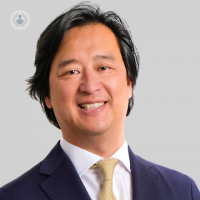PRESERFLO™ MicroShunt: The new device revolutionising glaucoma surgery
Written in association with:For patients with early to advanced primary open-angle glaucoma, trabeculectomy has been the go-to treatment to help reduce pressures. Recently, the PRESERFLO™ MicroShunt has been drawing attention, offering a safer and less invasive alternative to managing this progressive eye disease.
Internationally-renowned London consultant ophthalmologist, Professor Kin Sheng Lim, explains more about this exciting development.

What is the PRESERFLO™ MicroShunt device and what does it treat?
The PRESERFLO™ MicroShunt is a ‘minimally’ invasive glaucoma drainage device. It is a small tube about 8mm in length and it is inserted into the eye to drain fluid build-up in glaucoma patients.
Glaucoma is a common disease that causes a build-up of fluid in the eye and resulting in high pressure and damage to the optic nerves. The MicroShunt implant provides an alternative drainage pathway to lower that pressure. The surgery itself is similar to a trabeculectomy but it is much simpler to perform and, once the implant is inside the eye, it isn’t visible without a microscope.
What advantages does this device offer?
The implant works by lowering the eye pressure from the build-up of fluid and stops any further damage to your eye. Given that the MicroShunt tube is small enough to prevent over-drainage, it is thought to be safer than a traditional trabeculectomy. Furthermore, the surgery is less traumatic to the eye and only takes around 20 minutes to perform.
The recovery time from this procedure is generally quicker and the follow-up visit is also less intensive than after a traditional trabeculectomy. The traditional recovery time is typically between four to six weeks for trabeculectomy, while the recovery from a MicroShunt implant is generally around two weeks.
How is it performed?
This procedure can be performed under local or general anaesthetic. The surgery is usually combined with medication called Mitomycin-C to reduce scarring, similar to a trabeculectomy.
The tube is implanted under the thin membrane covering the white of your eye and the skin is then closed with a few small stitches. These stitches are permanent and won’t need to be removed later on.
Who is eligible for this treatment?
All patients who are suitable to undergo a traditional trabeculectomy can have this surgery. Glaucoma patients whose condition is progressing will very often need this treatment. It’s generally recommended for all stages of glaucoma, but it is usually performed in patients who either don’t have significant cataracts or have had a previous cataract operation.
What are the risks?
MicroShunt surgery can cause serious complications, although these are very rare. Sometimes, a small amount of haemorrhage or bleeding in the eye can happen, or pressure may become too low or high after the implantation. There is a small chance of needing to have a revision after and there is a long-term risk of infection, just like any glaucoma surgery.
How successful is this treatment?
The treatment is as successful as a traditional trabeculectomy, but with fewer complications and less intensive post-op visits and management. Recovery is quicker and the eyes typically feel very comfortable afterward.
Professor Kin Sheng Lim is an expert in the PRESERFLO™ MicroShunt implantation procedure and performs it at his clinics in London. To make a consultation with him, don't hesitate to visit his Top Doctors profile today to check his availability.


